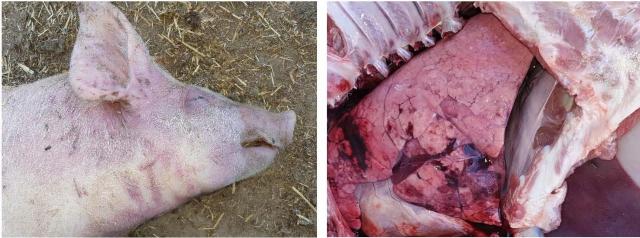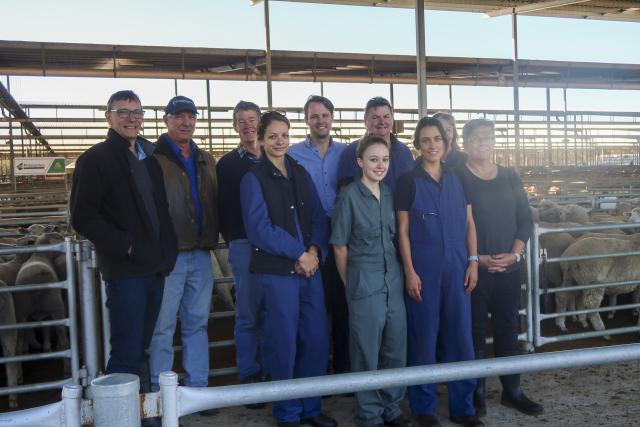Livestock disease investigations protect our marketsAustralia’s ability to sell livestock and livestock products depends on evidence from our surveillance systems that we are free of particular livestock diseases. The WA livestock disease outlook – for vets summarises recent significant disease investigations by Department of Primary Industries and Regional Development (DPIRD) vets and private vets that contribute to that surveillance evidence. |
Recent livestock disease cases in WA
African swine fever excluded as the cause of disease in a pig herd

- In May, a pig producer reported respiratory disease and deaths in 11-week-old pigs to their private vet. This vet, recognising the signs as potentially being consistent with a reportable disease, immediately contacted a DPIRD Field Veterinary Officer (FVO). Only one batch of pigs on the property was affected.
- The first signs of disease had been seen two days prior, with a significant increase in mortalities and animals showing lethargy, inappetence, reduced water intake and respiratory difficulties. The producer reported purple discolouration of the ventrum, face and ears in some sick pigs (see Image 1), and a bloody nasal/oral discharge in some of the dead pigs.
- The DPIRD FVO conducted an on-farm investigation and post-mortem of eight pigs. On post-mortem, pigs were noted to be in good body condition with evidence of pleurisy and pneumonia, including haemorrhagic, friable lungs (see Image 2).
- Fresh and fixed tissues, blood samples and swabs were submitted to the DPIRD laboratory with differential diagnoses including Actinobacillus pleuropneumoniae pleuropneumonia (APP), pasteurellosis, mycoplasmosis, Glasser’s disease and salmonellosis.
- As the clinical signs may have indicated exotic diseases such as African swine fever (ASF) or classical swine fever (CSF), exclusion testing (PCR and serology) was conducted, which was negative.
- Histopathology showed severe bronchopneumonia and pleuritis with lymphadenitis.
- Bacterial culture was positive for APP from lung and pericardial swabs, resulting in a diagnosis of APP pneumonia.
- ASF is currently spreading across Europe and Asia, and poses a major threat to pig-producing countries that are free of the disease, such as Australia.
- Always report any unusual deaths or suspicion of ASF to a DPIRD field vet or the Emergency Animal Disease hotline on 1800 675 888. Early detection = faster eradication. Please share this message with your networks who have contact with domestic or wild pigs, including veterinary colleagues, the pork industry and hunting groups.
Private vet investigates neurological signs in dairy heifers in the South-West
- In a herd of 800 dairy heifers, one died and two were unwell with progressive ataxia, circling and recumbency. The heifers had recently calved, and were being fed silage.
- Prior to death, a drooping eyelid and flaccid lips on one side of the face were noted on the heifer. A private vet attended the property and during a post-mortem examination found copious brown-tinged cerebrospinal and subdural fluid. A full sample set was submitted to the DPIRD laboratory, with a provisional diagnosis of listeriosis.
- Histopathological examination revealed a chronic meningoencephalitis and ventriculitis. Bacterial cultures of the cerebrospinal fluid and spinal cord isolated growths of Trueperella pyogenes and haemolytic E. coli.
- There were no typical listeriosis lesions (microabscessation in the hindbrain), and specific bacterial cultures for Listeria were negative.
- The cow was diagnosed with meningoencephalitis, likely due to the mixed bacterial infection.
- Reportable diseases including transmissible spongiform encephalopathy and lead toxicity were excluded as the cause of disease and deaths in this case.
- The vet received a subsidy to conduct the on-farm investigation and post-mortem under the Significant Disease Investigation (SDI) program. This subsidy is available for approved significant disease incidents in livestock and wildlife. See the SDI webpage for details.
In early winter, watch for these livestock diseases
Disease, typical history and signs | Key samples |
Arthritis in lambs
| Post-mortem:
|
Grass tetany in cattle
| Ante-mortem:
Post-mortem:
|
Can you spot your local DPIRD field vet?
DPIRD held four regional workshops in late May to update private vets about the latest information in animal health surveillance. DPIRD field vets also participated in a practical workshop at Katanning Saleyards. Thanks to Rod Bushell (second left), Katanning Saleyards manager, for his assistance. Pictured are Graham Mackereth (left), Broome; Kevin Hepworth, Bunbury; Vanessa Rushworth, South Perth; Andrew Larkins, Albany; Kristine Rayner, Katanning; Rod Thompson, Northam; Courtenay Bombara, Moora; Marion Seymour, Surveillance Manager; Anna Erickson, Narrogin. For more details, see the media release: Vet workshops support WA’s high biosecurity status.

